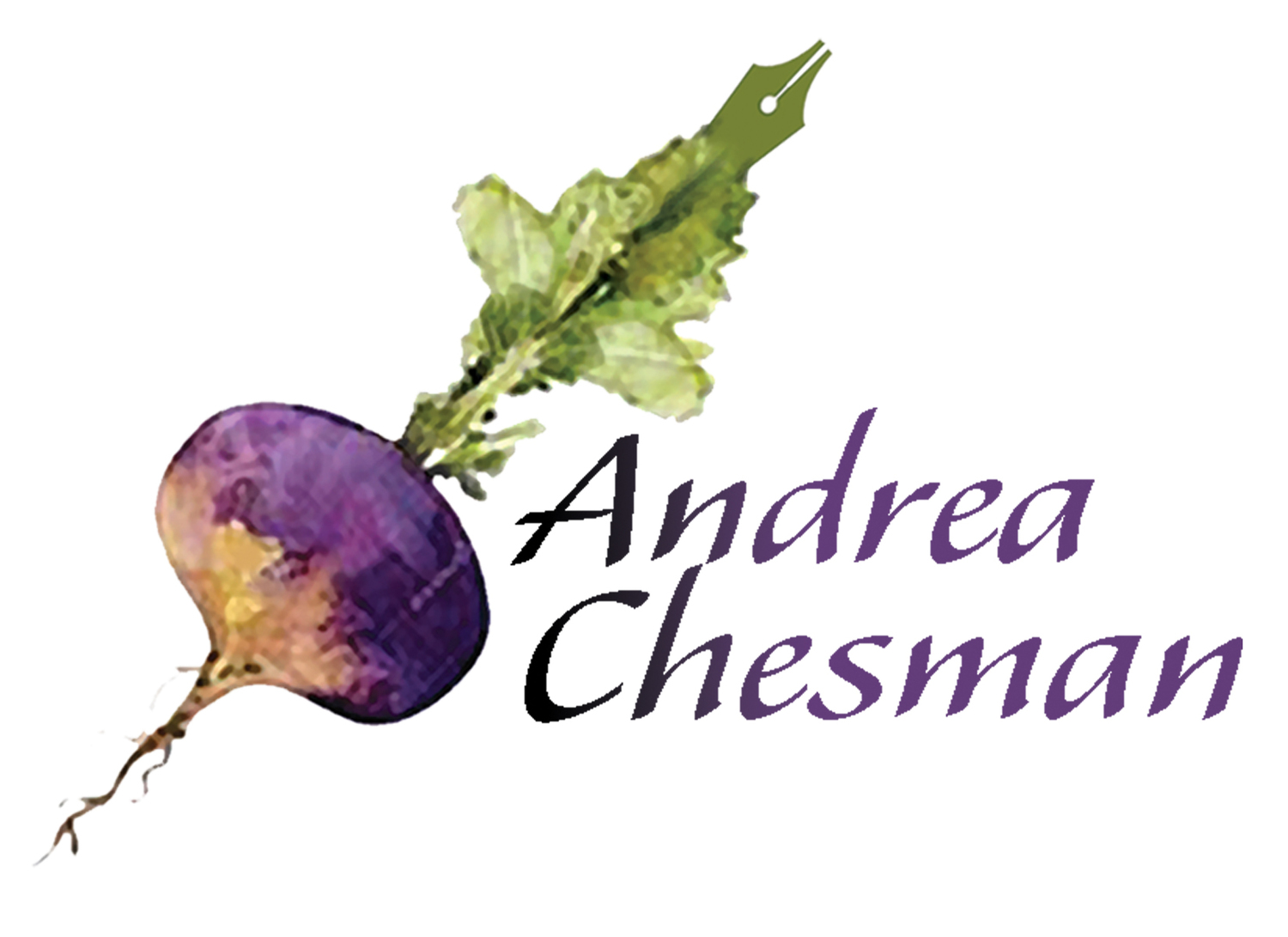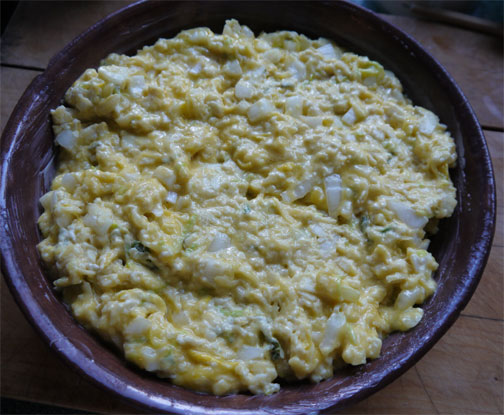
A few years ago I received a phone call asking me if I was interested in taking on a revision of Garden Way’s classic Zucchini Cookbook, in honor of the twenty-fifth anniversary of its original publication. As a freelance writer who was in between projects, I was happy to say yes.
Contracts were signed, zucchini was planted, meetings arranged. At one of those meetings, I happened to mention to the sales manager at Storey Publishing that I thought zucchini was basically a very bland vegetable, and his jaw dropped. But that’s a good thing, I hastened to add. Because it means that you can do a lot with it.
That an overabundance of zucchini can be a problem is uncontestable. Every article I have ever read about zucchini mentions a New England suburban myth: Why do Vermonters (or New Yorkers, or Mainers, or whatever – you supply whatever applies to you) have to lock their car doors every August? To keep people from filling their cars with zucchini, of course!
It happened to me. One September, my husband and I threw a birthday bash in the Ripton Community House for 100 of our closest friends and while my back was turned, the deed was done.
I don’t know when I’ve had more fun in the kitchen.
Making up recipes for zucchini is almost like child’s play. You can do anything with zucchini, and get good results.
My breakthrough moment in the kitchen occurred about a week after attending a zucchini festival. I heard rumors of “mock apple pies” made with zucchini instead of apples. I followed the directions I was given and was amazed at its resemblance to apple pie. If you peel zucchini and cook it in lemon juice with enough sugar and spice, you get something very much like apple pie filling. I took the pie on a picnic and completely enjoyed the incredulous looks I received when I told my friends the pie was made with zucchini, not apples. I had fooled almost everyone.
My son looked up from his slice and told me I should call it “Zapple Pie.” After the Zapple Pie, we started thinking up recipe titles. Zapple Pie was swiftly followed by Zesto Pesto Pizza (pesto plus zucchini) and Zingerbread (gingerbread plus zucchini). This was fun, and the recipe-testing results were delicious. We moved on to Zesto Pasta Salad and Zapple Strudel – not to mention Squococonut Pie – coconut custard pie made with yellow squash and coconut flavoring, but no coconut.
Even without cooks disguising squash as apples, this vegetable has a history of causing confusion. While Europeans were cultivating various types of gourds, New World natives were enjoying squash and pumpkins for at least 7000 years. The confusion arose when the first European explorers visited the Americas and reported that the natives were cultivating a new type of melon. It was a mistake made again and again, because the Europeans had never seen anything like squash, and so they had no word for it. Nonetheless, squash was readily adopted by the first European settlers, who couldn’t be too choosy, given their circumstances.
Squash, when young and unripe, is summer squash. When ripe and hard-shelled, it becomes winter squash. According to botanists, there is no firm line winter squash from summer squash, or winter squash from pumpkins, for that matter. Basically there are four types of edible squashes. Cucurbita pepo is noted for its pentagonal stems with prickly spines. This group includes zucchini and all the summer squashes, as well as pumpkins, acorn squash, spaghetti squash, and numerous gourds. Butternut squash, which is one of the best replacements for pumpkin in any recipe, is in another grouping entirely (C. moshata, which has pentagonal stems without spines). C. maxima (round stems) includes buttercup, Hubbard, and turban squashes.
Winter squash and pumpkin rapidly became staples in New World kitchens, but summer squash were not common until the 1950s, when the zucchini was re-introduced from Italy. It came via a circuitous route. Sometime in the 1820s, a South American squash called the Valparaiso was introduced to Europe. As it was adopted, the long, thick, meaty squash became known as the vegetable marrow of England and the cocozelle of France and Italy. Increasing travel in the post-war era meant that Americans slowly broadened their palates and refrigerated rail cars and other technological improvements allowed a wider range of foods to become available. Home gardeners were the first to pick up the zucchini, and it was accepted quite rapidly. Today zucchini and other summer squash are supermarket staples.
Most summer squash recipes are interchangeable. All of the summer squash have tender, edible skins and flesh that ranges mild and nutty to buttery or cucumber-like. But the shapes and appearance vary considerably. With more and more varieties available from garden seed catalogs, farm stands, and supermarkets, it is fun to experiment with new types.
Unless you are preparing squash to masquerade as apple, don’t peel the squash as this is where most of the nutrition, fiber, and flavor lie.
My standard summer vegetable dish starts with extra virgin olive oil in a skillet. Next I throw in chopped garlic and chopped vegetables, which usually means summer squash. Maybe I’ll throw in a handful of green beans, some corn stripped off the cob, chopped Swiss chard, or diced bell pepper. I sauté the veggies until tender, about 5 minutes. Finally, I’ll add some chopped tomato and/or basil and season generously with salt and pepper. It’s never quite the same dish, and we never tire of it.
Here’s two recipes to get the summer squash out of your garden and onto the table.
Ratatouille
Serves 6 to 8
In the perfect ratatouille, the flavors are blended, yet each vegetable remains distinct. The vegetables are neither mushy nor undercooked. To do this properly, sauté each vegetable separately in a large skillet and then combine them in a saucepan just long enough to blend the flavors. Chopped fresh basil, or a little thyme or oregano makes fine additions.
7 tablespoons extra virgin olive oil
1 medium-sized eggplant, peeled and diced
Salt and freshly ground black pepper
1 onion, diced
1 small green bell pepper, diced
1 small red bell pepper, diced
2 small zucchini, diced
2 small yellow summer squash, diced
2 ripe tomatoes, seeded and diced
4 garlic cloves, minced
1 (8-ounce) can unseasoned tomato sauce or tomato puree
1. In a large skillet over medium-high heat, heat 3 tablespoons of the oil. Add the eggplant and season with salt and pepper. Sauté until browned, juicy, and cooked through, 10 to 12 minutes. Transfer to a medium saucepan with a slotted spoon.
2. Return the skillet to medium-high heat and add 2 more tablespoons of the oil. Add the onion and bell peppers and sauté until tender-crisp, 3 to 5 minutes. Transfer to the saucepan with a slotted spoon.
3. Return the skillet to medium-high heat and add the remaining 2 tablespoons oil. Add the zucchini and summer squash and season with salt and pepper. Sauté until tender-crisp, 3 to 5 minutes. Transfer to the saucepan and add the tomatoes, garlic, and tomato sauce.
4. Simmer the ratatouille for 15 minutes over medium heat.
5. Taste and adjust the seasoning. You can serve immediately, but the flavor will improve if the ratatouille sits at room temperature for 1 to 2 hours. Serve at room temperature, or reheat and serve warm.
From Serving Up the Harvest. © Andrea Chesman, 2006. All rights reserved.
Zapple Pie with a Streusel Topping
In the tradition that began with a recipe on the back of a box of Ritz crackers comes this ultimate mock apple pie, made from zucchini. I love to serve this pie to the unwitting and watch their response when I tell them it was made from zucchini. This is a delicious pie – and you can’t help smiling as you eat it.
6 cups peeled, quartered, and thinly sliced zucchini (about 2 pounds)
3/4 cup sugar
2 teaspoons ground cinnamon
1/4 teaspoon ground nutmeg
1/2 cup plus 2 tablespoons fresh lemon juice
1/3 cup unbleached all-purpose flour
1 unbaked 9- or 10-inch pie shell
Topping
1/2 cup unbleached all-purpose flour
1/2 cup packed light brown sugar
1/4 cup butter
1 teaspoon ground cinnamon
1 cup chopped pecans or walnuts
1. To make the filling, combine the zucchini, sugar, cinnamon, and nutmeg in a medium saucepan over medium heat. Add the 2 tablespoons lemon juice. Stir to mix and cook until tender but not mushy, about 15 minutes, stirring frequently.
2. Dissolve the flour in the remaining 1/2 cup lemon juice. Stir into the zucchini. Continue to cook until the mixture thickens, 2 to 3 minutes. Remove from the heat.
3. Preheat the oven to 450° F.
4. Make the topping. Combine the flour, brown sugar, cinnamon, and butter in a small bowl. Cut in the butter until the mixture is crumbly. Stir in the pecans.
5. Spoon the filling into the pie shell. Top with half of the streusel topping. Place in the oven and reduce the oven temperature to 350° F. Bake for 30 minutes, until the crust is browned and the filling is bubbling.
6. Sprinkle the remaining topping over the pie. Turn on the broiler. Run the pie under the broiler for about 3 minutes, until the topping is browned.
7. Set the pie on a wire rack to cool. Serve warm or completely cooled. This is best served on the day it is made.
From The Classic Zucchini Cookbook © 2002, 1990. 1977 by Storey Publishing. All rights reserved.







